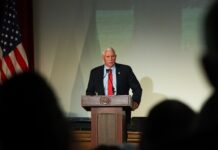After the Navy Yard shooting that resulted in the death of 12 people including one Slippery Rock alumnus, the question of gun rights often gets brought up in the media.
The Second Amendment is usually cited when talking about gun rights, but not many people know why the second amendment was created in the first place.
“Rights that people have are broad but not unlimited,” explained SRU history professor Dr. William Bergmann. “For example one can own military style weapons, but cannot own a machine gun. So the federal government allows for broad gun ownership but they do have power to regulate. The legal question is where are the boundaries of political authorities in that regard?”
Although there are many scholarly interpretations about how the second amendment was agreed upon, there is a generally accepted understanding of how people interpreted gun rights during the era of the early republic. Bergmann clarified that the early understanding of gun rights was very different from the modern views of gun laws.
Before the American Revolution, it was an assumed right that people were allowed to have guns to hunt and to protect themselves on the frontier. At this point in time, gun rights were not written laws.
At the time, the Articles of Confederation served as the first constitution of the United States. The federal government had no power over gun rights because most of the power to govern people was given to the individual states.
Many states began to articulate their gun rights instead of simply having them be assumed. There were two different contexts to the rights. The first was to insure that people could hunt in order to support their families. The second was to establish local militias as a form of defense, because there was no national military at the time.
“There were debates about whether or not to include gun rights specifically for hunting within state constitutions,” Bergmann explained. “People said, ‘why would we put something like that in there when it’s the kind of thing that we naturally have?’ There’s another quote along the lines of, ‘ maybe we should also write about the right to breath or the right to sleep on one’s left hand side at night,’ because that’s how fundamental the right to own a gun to hunt was seen.”
The issue of militias raised completely different questions then the issue of gun rights for hunting, Bergmann said. If guns were to be used for the purpose of having a militia, the state government would have to regulate gun ownership. The guns used by a militia would not be the same types of guns that people would use for hunting. The severity of these regulations differed from state to state.
On the opposite side of the same argument was the questions of the right not bear arms. Specifically many Quakers lived in Pa. and they were all pacifists. Because they were pacifists, they refused to serve in the militias, which upset the non-Quakers who were defending the people who refused to defend them.
“The language ’to bear arms’ in this case is not the individual’s right to bear arms but rather the individual’s obligation to their community to defend their community by bearing arms,” Bergmann said. “So in this sense, ‘baring arms’ is about one’s obligation to one’s community for purposes of defense. This is a part of gun ownership at the time that was not assumed, but debated.”
When the Constitution was made 1789, there was much debate over the Bill of Rights. According to Bergmann, the founders were very concerned with the language that would be used.
“Historically from the debate, it seems pretty clear that what they were attempting to do was to deal with militia, not the right to hunt,” Bergmann said. “A well-regulated Militia, being necessary to the security of a free State, the right of the people to keep and bear Arms, shall not be infringed,” the Second Amendment states.
Bergmann explained that most scholars agree that the part about the militia is written first because it was the most important aspect of the amendment. It gave the right to regulate militias to the national government. In a way, this was an early predecessor to the National Guard. The modern day National Guard can be called into action by either the national or state governments depending on where they are needed.
Shortly after the Second Amendment was passed, congress began passing militia acts which began regulating militias in order organize them to serve as national defense.
In the early 19th century, the Fourteenth Amendment was passed which changed how people interpreted gun laws.
“Before the Fourteenth Amendment, the Bill of Rights did not protect you against the state infringing on your rights,” Bergmann explained. “The Bill of Rights was just about the relationship to the federal government, not about your relationship to the states. That was different, the states dealt with these issues on their own. What this did was standardize everything.”
When the National Guard was created, the issue of owning a gun for a militia is eliminated, so the question of individual gun ownership becomes the focus of the Second Amendment.
According to Bergmann both the left-wing and right-wing sides of the current political debate are wrong in a sense because they are not speaking for what the founders intended but rather for their own modern interests.
“The right is wrong in interpreting the founding era as establishing the individual’s right to bear arms individually so that they could defend themselves against a tyrannical state,” Bergmann explained. “That’s not what the founders intended the well-regulated militia to be.”
“The left is wrong in thinking that the state has a right to get rid of guns and that the founders didn’t mean for that,” Bergmann said “They are wrong because not only did the founders intend for people to have guns, but they intended to force people to bear guns for your community.”
Read the Rocket next week for part 2 of the Gun Series, which will cover gun rights on SRU campus.







